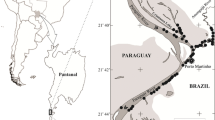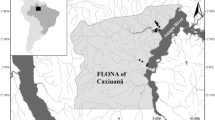Abstract
A total of 552 individuals of Rioraja agassizi (257 females and 295 males) were collected by bottom-trawl during research cruises. Sexual dimorphism was observed with females are heavier than males for a given total length (TL). Using logistic regression, it was determined that TL at 50% maturity of males was 475 mm TL and of females 520 mm TL. This estimation agrees with the morphological parameters measured. Although not statistically significant, a peak in reproductive activity was observed in males during late spring and summer. The monthly variation in the gonadosomatic index and oviducal gland width, together with the largest diameter of ovarian follicles, suggests that R. agassizi females have a partially defined annual reproductive cycle with two peaks, one from November (spring) to February (summer) and another in July (winter).







Similar content being viewed by others
Notes
Oviducal gland refers to the portion of oviduct that produces the rigid egg capsule, the thin pliable transient egg candle case and egg jelly that surrounds the fertilized egg (Hamlett et al. 1998).
References
Braccini JM, Chiaramonte GE (2002) Reproductive biology of Psammobatis extenta. J Fish Biol 61:272–288
Coelho R, Erzini K (2006) Reproductive biology of the undulate ray, Raja undulata, from the south coast of Portugal. Fish Res 81:80–85
Craik JCA (1978) An annual cycle of vitellogenesis in the elasmobranch Scyliorhinus canicula. J Mar Biol Assoc UK 58:719–334
Dulvy NK, Reynolds JD (2002) Predicting extinction vulnerability in skates. Conserv Biol 16:440–450
Dulvy NK, Metcalfe K, Glanville JD, Pawson J, Reynolds MG (2000) Fishery stability, local extinction, and shift in community structure in skates. Conserv Biol 14:283–293
Ebert DA (2005) Reproductive biology of skates, Bathyraja (Ishiyama), along the eastern Bering Sea continental slope. J Fish Biol 66:618–649
Guerrero RA, Acha EM, Framiñan MB, Lasta CA (1997) Physical oceanography of the Río de la Plata estuary, Argentina. Cont Shelf Res 17:727–742
Hamlett WC, Knight DP, Koob TJ, Jezior M, Luong T, Rozycki T, Brunette N, Hysell MK (1998) Survey of oviducal gland structure and function in elasmobranchs. J Exp Zool 282:399–420
Hoeing JM, Gruber SH (1990) Life-history patterns in elasmobranchs: implications in fisheries management. NOAA Technical Report, NMFS-90, 16 pp
Hoffmayer ER, Parson GR, Horton J (2006) Seasonal and interannual variation in the energetic condition of adult male Atlantic sharpnose shark Rhioprionodon terranovae in the northern Gulf of Mexico. J Fish Biol 68:645–653
Holden MJ, Rout DW, Humphreys CN (1971) The rate of egg laying by three species of ray. J Cons Int Explor Mer 33:335–339
Jaureguizar AJ, Menni RC, Lasta CA, Guerrero R (2006) Fish assemblages of the northern Argentine coastal spatial patterns and their temporal variations. Fish Oceanogr 15:326–344
Klimley AP (1987) The determinants of sexual segregation in the scalloped hammerhead shark, Sphyrna lewini. Environ Biol Fish 18:27–40
Lasta CA, Carozza CR, Ruarte CO, Jaureguizar AJ (1999) Ordenamiento pesquero en el ecosistema costero bonaerense (Fishery classification of Buenos Aires coastal ecosystem). Informe Técnico Interno INIDEP (INIDEP technical report, Argentina) N° 25, 20 pp
Lucas AJ, Guerrero R, Mianzán H, Acha EM, Lasta CA (2005) Coastal oceanographic regimen of the Northern Argentina Continental Shelf (34°–43°S). Estua Coast Shelf Sci 65:405–420
Mabragaña E, Cousseau MB (2004) Reproductive biology of two sympatric skates in the south-west Atlantic: Psammobatis rudis and Psammobatis normani. J Fish Biol 65:559–573
Mabragaña E, Lucifora LO, Massa AM (2002) The reproductive ecology and abundance of Sympterygia bonapartii endemic to the south-west Atlantic. J Fish Biol 60:951–967
Mabragaña E, Lucifora LO, Colonello JH, Saicha V, Bernatene F (2004) Biología reproductiva de Sympterygia acuta (Chondrichthyes, Rajidae) en el Atlántico sudoccidental (Reproductive biology of Sympterygia bonapartii (Chondrichthyes, Rajidae) in southwestern Atlantic). XXIV Congreso Ciencias del Mar (XXIV Meeting of Science of the Sea), Chile
Martins IA, Martins CL, Leme MHA (2005) Biological parameters and population structure of Psammobatis extenta in Ubatuba region, north coast of the State of Sao Paulo, Brazil. J Mar Biol Assoc UK 85:1113–1118
Massa AM, Mabragaña E, Lucifora LO (2001) Reproductive ecology of the rio skate, Rioraja agassizi, from northern Argentina. IX COLACMAR (IX Latin American meeting of science of the Sea), Colombia
Massa AM, Lucifora LO, Hozbor NM (2004) Condrictios de la región costera bonaerense y uruguaya (Condrichthyans of Buenos Aires and Uruguayan coast). In: Boschi EE (ed) El Mar Argentino y sus recursos pesqueros. Los peces marinos de interés pesquero. Caracterización biológica y evaluación del estado del estado de explotación. INIDEP Press, Argentina, pp 85–99
Menni RC (1973) Rajidae del litoral bonaerense. I. Especies de los géneros Raja, Bathyraja y Sympterygia (Chondrichthyes) (Species of the genera Raja, Bathyraja and Sympterygia (Chndrychthyes)). Physis (Argentina) A 32:413–439
Menni RC, Lopez HL (1984) Distributional patterns of argentine marine fishes. Physis (Argentina) A 42:71–85
Menni RC, Stehmann MFW (2000) Distribution, environment and biology of batoid fishes off Argentina, Uruguay and Brazil. A review Rev Mus Argentino Ciencias Nat (J Argent Nat Hist Mus) 2:69–109
Oddone MC, Vooren CM (2005) Reproductive biology of Atlantoraja cyclophora (Regan 1903) (Elasmobranchii: Rajidae) off southern Brazil. ICES J Mar Sci 62:1095–1103
Oddone MC, Paesh L, Norbis W (2005) Size at sexual maturity of two species of rajoi skates, genera Atlantoraja and Dipturus (Pisces, Elasmobranchii, Rajidae), from the south-western Atlantic Ocean. J Appl Ichthyol 21:70–72
Ruocco NL, Lucifora LO, Díaz de Astarloa JM, Wöhler O (2006) Reproductive biology and abundance of the white-dotted skate, Bathyraja albomaculata, in the Southwest Atlantic. ICES J Mar Sci 63:105–116
San Martín MJ, Perez JE, Chiaramonte GE (2005) Reproductive biology of the South West Atlantic marble sand skate Psammobatis bergi Marini, 1932 (Elasmobranchii, Rajidae). J Appl Ichthyol 21:504–510
Stehmann MFW (2002) Proposal of a maturity stages scale for oviparous and viviparous cartilaginous fishes (Pisces, Chondrichthyes). Arch Fish Mar Res 50:23–48
Sulikowski JA, Tsang PCW, Howell WH (2004) An annual cycle of steroid hormone concentrations and gonad development in the winter skate, Leucoraja ocellata, from the western Gulf of Maine. Mar Biol 144:845–853
Sulikowski JA, Tsang PCW, Howell WH (2005a) Age and size at sexual maturity for the winter skate, Leucoraja ocellata, in the western Gulf of Maine based on morphological, histological and steroid hormone analyses. Environ Biol Fish 72:429–441
Sulikowski JA, Kneebone J, Elzey S (2005b) The reproductive cycle of the thorny skate (Amblyraja radiata) in the western Gulf of Maine. Fish Bull 103:536–543
Tamini LL, Chiaramonte GE, Perez JE, Cappozzo HL (2006) Batoids in a coastal fishery of Argentina. Fish Res 77:326–332
Templeman W (1987) Differences in sexual maturity and related characteristics between populations of thorny skate (Raja radiata) from the Northwest Atlantic. J Northw Atl Fish Sci 7:155–167
Walker PA, Hislop JRG (1998) Sensitive skates or resilient rays? Spatial and temporal shifts in ray species composition in the central and north-western North Sea between 1930 and the present day. ICES J Mar Sci 55:392–402
Walmsley-Hart SA, Sauer WHH, Buxton CD (1999) The biology of the skates Raja wallacei and R. pullopunctata (Batoidea: Rajidae) on the Agulhas Bank, South Africa. S Afr J Mar Sci 21:165–179
Whittamore JM, McCarthy ID (2005) The population biology of the thornback ray Raja clavata in Caernarfon Bay, north Wales. J Mar Biol Assoc UK 85:1089–1094
Zar H (1984) Biostatistical analysis, 2nd edn. Englewood Cliffs, Prentice Hall, 718 pp
Acknowledgements
This paper is part of J. Colonello PhD thesis and was supported by CONICET and INIDEP. JHC would like to thank the American Elasmobranch Society for travel funds to attend this meeting where this paper was presented as part of a symposium on the biology of skates. We wish to express our gratitude to crews of the INIDEP and to C. Carozza and A. Massa. We also thank R. Menni, A. Milessi, A. Vagelli, G. Ortí, D. Ebert and J. Sulikowski for comments and suggestions. INIDEP contribution Number 1440.
Author information
Authors and Affiliations
Corresponding author
Rights and permissions
About this article
Cite this article
Colonello, J.H., García, M.L. & Lasta, C.A. Reproductive biology of Rioraja agassizi from the coastal southwestern Atlantic ecosystem between northern Uruguay (34°S) and northern Argentina (42°S). Environ Biol Fish 80, 277–284 (2007). https://doi.org/10.1007/s10641-007-9239-0
Received:
Accepted:
Published:
Issue Date:
DOI: https://doi.org/10.1007/s10641-007-9239-0




